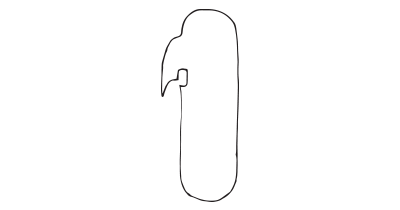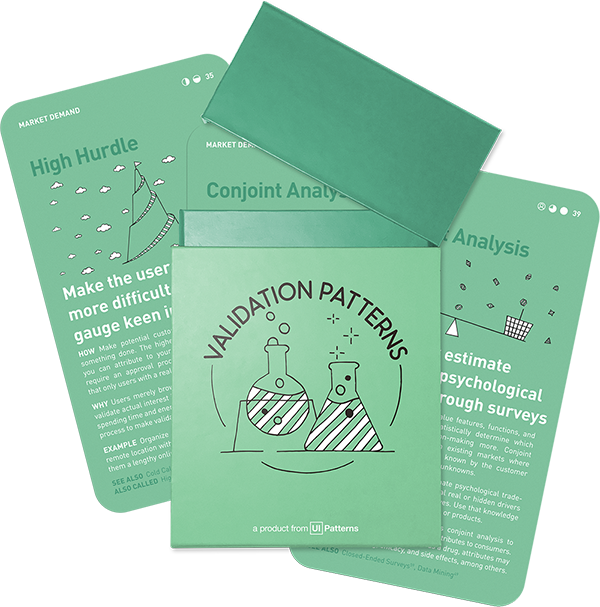Evidence strength
Relevant metrics: Acquisition, Activation, Customer feedback, Email Sign ups
Validates: Feasibility, Viability, Desirability
How: Build a product that only solves one specific problem that your customers are having Ð typically a tool with one single feature.
Why: Building just a single feature is a powerful way to start, as you are focused on solving one very specific problem for a very specific niche group better than anyone else. Chances are your early adopters will give you valuable insight into how your product should eventually evolve into a platform.
This experiment is part of the Validation Patterns printed card deck
A collection of 60 product experiments that will validate your idea in a matter of days, not months. They are regularly used by product builders at companies like Google, Facebook, Dropbox, and Amazon.
Get your deck!Before the experiment
The first thing to do when planning any kind of test or experiment, is to figure out what you want to test. To make critical assumptions explicit, fill out an experiment sheet as you prepare your test. We created a sample sheet for you to get started. Download the Experiment Sheet.
Narrowing the focus
The Single Feature Product experiment is a strategy used to test the viability of a larger, more complex product concept in the market. The idea is to focus on just a single, core feature of a proposed product and developing it as a standalone offering. The objective is to gather insights about the market’s response to this feature before committing significant resources to the development of the full product.
By narrowing down the product experience you are interested in testing and isolating it in its own single feature product, your test results will provide clearer evidence than if the feature had been integrated with other features. The fewer variables than can influence results, the better data reliability you will get.
The primary goal of a Single Feature Product is to validate a market need. It allows companies to test whether the core functionality of their product addresses a real problem or need in the market. By receiving direct feedback from early users, businesses can gauge the demand and potential success of their full product.
Developing a product with only one feature significantly reduces the time and resources needed for its launch. It allows startups to avoid the high costs and risks associated with developing a full-scale product without prior validation of the concept.
Control damages to your brand
When you launch a product as a single-feature product, customer expectations are aligned to only expect a single feature. Especially for larger and more well-established brands that risk damaging their brand if experiments run wild, packacking the experiment as a single-feature product without ties to the brand’s core offering, can be beneficial.
Understand before you scale
Engaging users with a single feature enables a deeper understanding of how they interact with the product. Companies can learn about user behavior, preferences, and pain points, which are vital insights for the development of the full product.
Once the single feature gains traction, the business can scale it by adding more features and functionalities based on user feedback and market demand. This gradual evolution helps in building a more robust and market-fit product.
The primary challenge of this strategy is ensuring that the simple scope is sufficiently compelling to attract users. Additionally, businesses must be prepared to pivot or adapt their strategy based on the feedback and data collected through this initial market test.
After the experiment
To make sure you move forward, it is a good idea to systematically record your the insights you learned and what actions or decisions follow. We created a sample Learning Sheet, that will help you capture insights in the process of turning your product ideas successful. Download the Learning Sheet.
Examples
FiveSecondTest.com
Before releasing as part of their core offering, UsabilityHub launched fivesecondtest.com - a single feature product that was later incorporated into their core offering.
Source: Five second test
Foursquare
Initially, Foursquare was a single-featured product that encouraged users to check in at various locations and earn badges. After gaining user traction, they added more features like recommendations and city guides.
Source: Foursquare
Stripe
Stripe started as a simple solution for online payment processing. The initial version, known as /dev/payments, had limited features but managed to process transactions within two weeks of its creation. This simple start helped them validate their idea and eventually grow into a significant player in the payment processing industry.
Source: The Ultimate List of MVP Examples [20+ Case Studies]
AngelList
AngelList began by offering email introductions to investors for founders. This simple test demonstrated the potential of their idea, leading to the expansion of their platform to include employee recruitment opportunities.
Source: The Ultimate List of MVP Examples [20+ Case Studies]
Product Hunt
Ryan Hoover, the founder of Product Hunt, initially used a link-sharing group to build a community for product enthusiasts. This approach validated his idea, leading to the development of a full platform.
Source: The Ultimate List of MVP Examples [20+ Case Studies]

